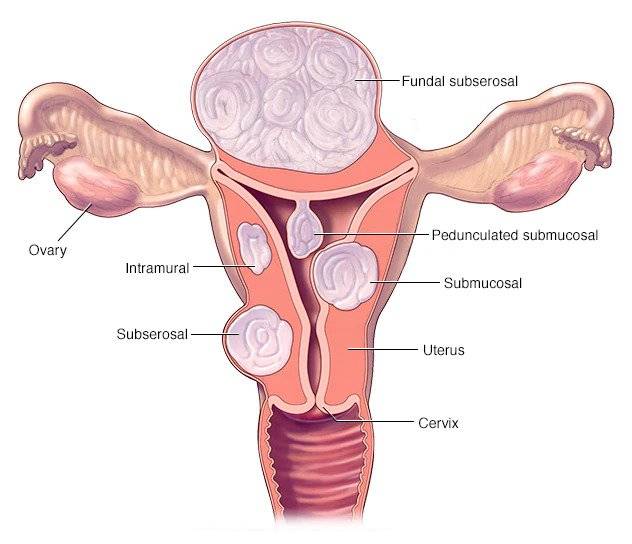Fibroids
Uterine fibroids are noncancerous growths of the uterus that often appear during childbearing years. Also called Leiomyomas or Myomas, uterine fibroids aren’t associated with an increased risk of uterine cancer and almost never develop into cancer.They may be single or multiple and may vary in size.
Types of Fibroids:
Fibroids can grow anywhere in the uterus and vary in size considerably. Some can be the size of a pea, whereas others can be the size of a melon. Fibroids can be of 3 types depending upon their location:
Submucous Fibroids – Located inside the cavity of the uterus
Intramural fibroids – Located inside the wall of the uterus
Subserous fibroids – They are on the outside surface of the uterus

Symptoms:
Many women who have fibroids don’t have any symptoms. In those that do, symptoms can be influenced by the location, size and number of fibroids.
In women who have symptoms (around 1 in 3), the most common signs and symptoms of uterine fibroids include:
Heavy menstrual bleeding
Menstrual periods lasting more than a week
Pelvic pressure or pain
Frequent urination
Difficulty emptying the bladder
Constipation
Backache or leg pains
Pain or discomfort during sex
Rarely, a fibroid can cause acute pain when it outgrows its blood supply, and begins to die.
Cause of Fibroids:
The exact cause of fibroids is unknown, but they have been linked to the hormone oestrogen.
Oestrogen is the female reproductive hormone produced by the ovaries (the female reproductive organs).
Fibroids usually develop during a woman’s reproductive years (from around the age of 16 to 50) when oestrogen levels are at their highest. They tend to shrink when oestrogen levels are low, such as after the menopause when a woman’s monthly periods stop.
Prevalence:
Fibroids tend to run in families, and affected women often have a family history of fibroids. Women of African descent are two to three times more likely to develop fibroids.
Diagnosis:
Pelvic examination
Ultrasound
MRI (rarely)
Treatment:
Fibroids do not need to be treated if they are not causing symptoms.
Over time, they’ll often shrink and disappear without treatment, particularly after the menopause. If you do have symptoms caused by fibroids, medicine to help relieve the symptoms will usually be recommended first.
There are also medications available to help shrink fibroids. If these prove ineffective, surgery or other, less invasive procedures may be recommended.
Observation – if the fibroids are not causing any symptoms they may not require any treatment. They may need to be monitored by regular ultrasound. In case there is a sudden increase in size one needs to be alert.
Medical Management
NSAIDS- NSAIDs, a class of medication, to treat cramping and pain caused by fibroids NSAIDs can help reduce symptoms. These medications do not shrink fibroids
Transexamic acid (TXA)- It is a medication that works to help blood clotting. By boosting the blood’s ability to clot, TXA helps decrease the amount of vaginal bleeding a woman experiences. This is used only in cases of severe bleeding. It’s generally not used long-term. While it does not shrink fibroids, but prevent excess bleeding.
GNRH AGONIST -Gonadotropin-releasing hormone (Gn-RH) agonists
This approach can provide an effective treatment for women nearing menopause who want to try medication for their symptoms. GnRh agonists decrease the estrogen and progesterone levels, thus menstruation stops, fibroids shrink over several months and anaemia often improves.
Surgical Treatment
Hysteroscopic Myomectomy – If the fibroid is inside the cavity of the uterus (submucous myoma), Hysteroscopic myomectomy is advised. Myomectomy is the process of removal of a fibroid. Hysteroscope is an instrument which is inserted through the vagina, cervix and then the uterus to remove the fibroid.
Laparoscopic Hysterectomy – Hysterectomy is a surgery where the uterus is removed. In laparoscopic surgery the removal is done with the help of laparoscope and this entails very small cuts on the tummy. This is associated with a faster recovery as compared to open surgery. This is done when the women does not desire future pregnancy.
Robotic Surgery
Robot assisted Laparoscopic Myomectomy – Myomectomy is the process to remove the fibroid. In laparoscopic surgery, very small incisions are given on the abdomen and a camera is inserted to see the insides of the abdomen. With robot assisted myomectomy large fibroids can also be rmoved after breaking them into smaller bits . Robot assisted surgery allows the surgeon to precisely dissect the fibroids from uterine wall. This helps help preserving fertility of the women .
Prognosis/Future:
Fibroids have a tendency to recur in some women.Fibroids that were larger and more numerous are most likely to recur.
